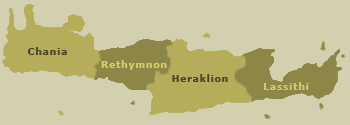It's hard to resist the many splendour charms of Crete. The legendary birthplace of Zeus, Crete boasts a landscape thatís quite diverse. Crete is the largest island in Greece and the second largest (after Cyprus) of the East Mediterranean. Crete has an elongated shape - 260 km from east to west and 60 km at its widest, although the island is narrower at certain points, such as in the region close to Ierapetra where it has a width of only 12 km. It covers an area of 8,336 km2 and has a coastline of 1046 km.
Its population is 650,000 people (as of 2005). The island of Crete lies approximately 160 km south of the Greek mainland.
Crete is extremely mountainous and is defined by a high mountain range crossing it from West to East, formed by three different groups of mountains. These are the White Mountains or Lefka Ori (2,452 m high); the Idi range (Psiloritis ( 2,456 m); the Dikti mountains (2,148 m high).
These mountains gifted Crete with fertile plateaus like Lasithi, Omalos and Nidha, caves like Diktaion and Idaion cave, and gorges like the famous Gorge of Samaria. The protected area of the Samaria Gorge is the home of kri-kri, a wild goat. Cretan mountains and gorges are refuges of the endangered spieces of Lammergeier (Gypaetus barbatus).














